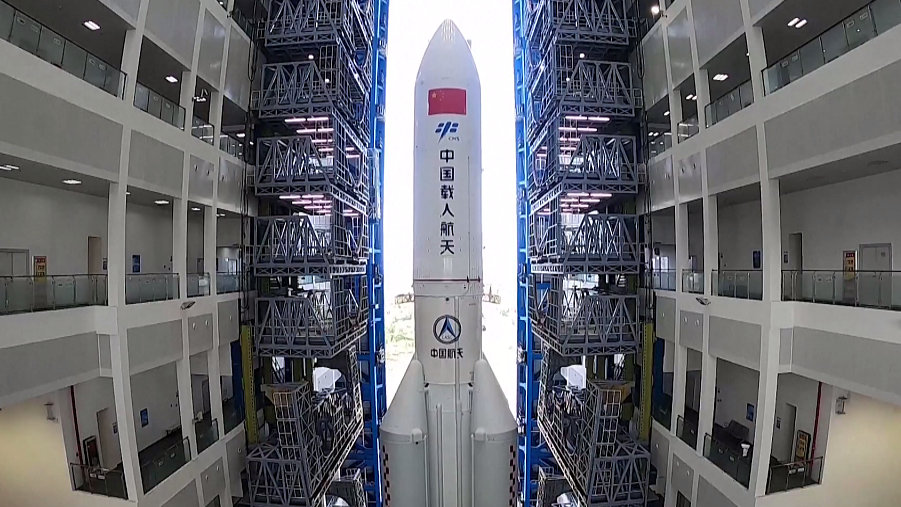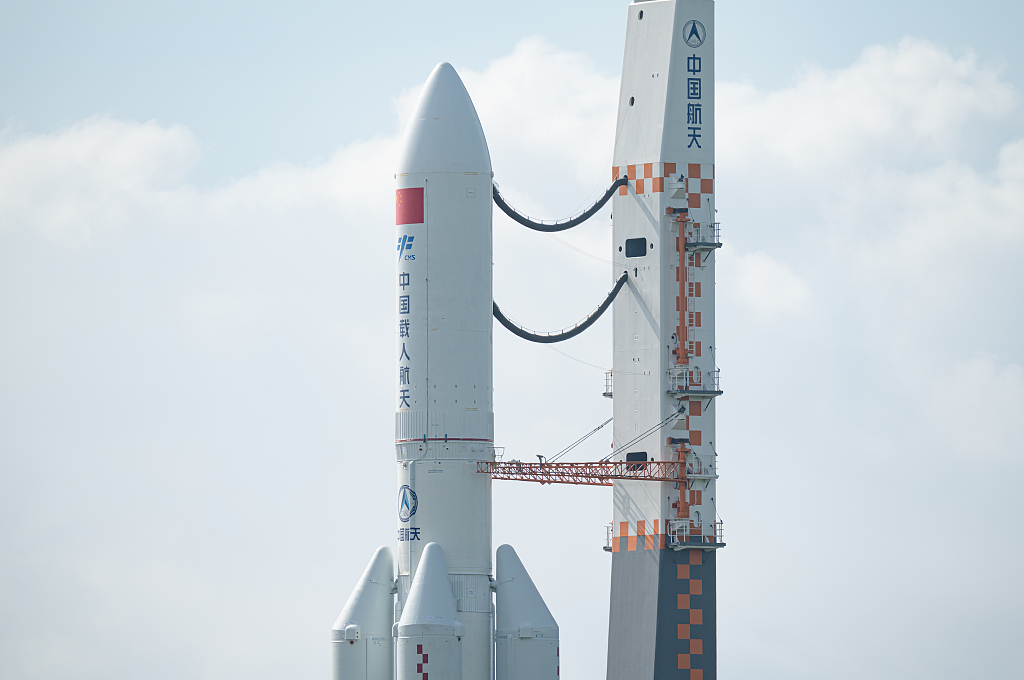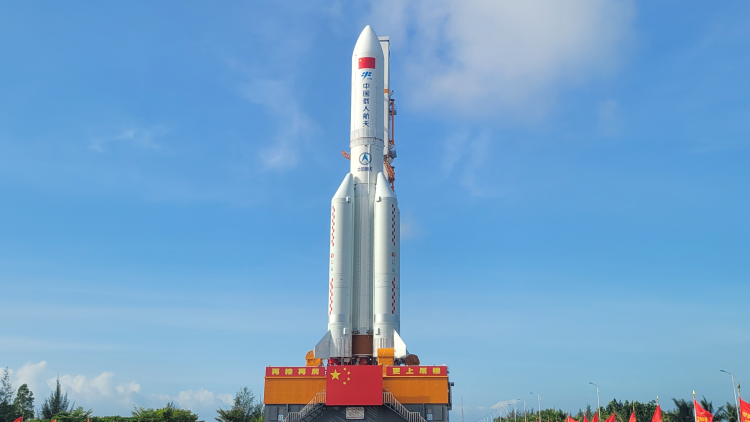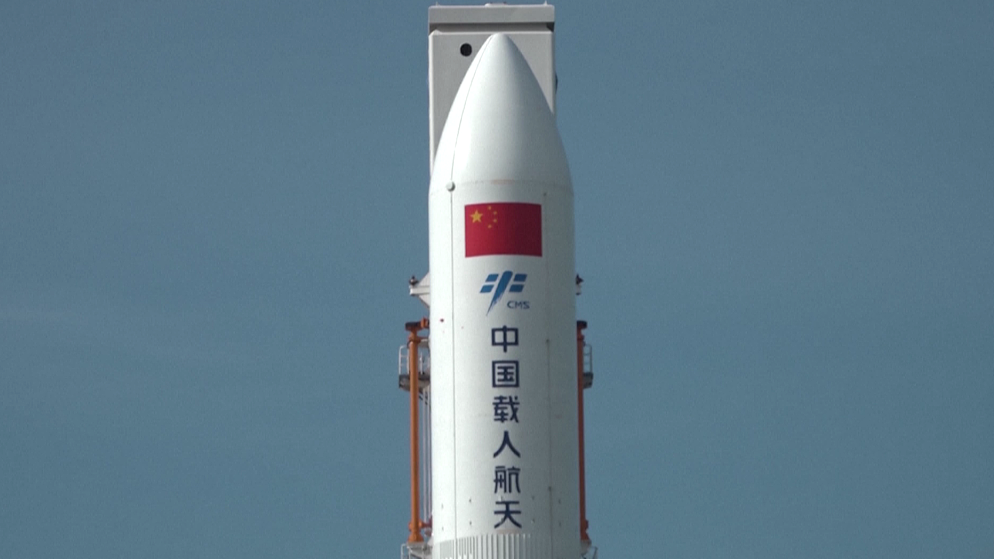
The Long March-5B Y3 rocket carrying the Wentian lab module is transported to the launchpad at the Wenchang Spacecraft Launch Site in south China's Hainan Province, July 18, 2022. /CFP
The Long March-5B Y3 rocket carrying the Wentian lab module is transported to the launchpad at the Wenchang Spacecraft Launch Site in south China's Hainan Province, July 18, 2022. /CFP
China's most powerful carrier rocket, the Long March-5B (LM-5B), is ready to transport one of the key modules necessary to assemble the country's space station.
The rocket, developed on the basis of the design of the Long March-5, is the most powerful heavy-lift rocket in China and is primarily used for low-Earth-orbit launches.
With a length of 53 meters and over 1,000 tonnes of thrust for taking off, the rocket can carry 25 tonnes of spacecraft to the designated orbit, making Chinese rockets' payload capacity among the world's best.
"The Wentian lab module is even larger in size compared to the core module," said Huang Bing, deputy chief designer of the LM-5B carrier rocket at the China Academy of Launch Vehicle Technology (CALT).
"It's still within the payload capacity of the LM-5B, though," Huang said.
China's space station consists of one core module and two lab modules. Each module is massive and weighs over 20 tonnes. The LM-5B rocket uses multiple technological breakthroughs, including an extra-large fairing and high thrust, to take the spacecraft into orbit.
"The LB-5B boosts our low-Earth orbit capacity from eight tonnes to 25 tonnes. It paves the way for space station construction," Huang said.
The Wentian launch will be the third such launch for the LM-5B rocket. Its maiden flight was in May 2020, when it successfully brought China's new generation test manned spaceship into orbit. One year later, LM-5B embarked on a journey to construct China's first-ever space station from scratch by successfully sending the core module of the space station Tianhe into orbit.

The Long March-5B Y3 rocket carrying the Wentian lab module is transported to the launchpad at the Wenchang Spacecraft Launch Site in south China's Hainan Province, July 18, 2022. /CFP
The Long March-5B Y3 rocket carrying the Wentian lab module is transported to the launchpad at the Wenchang Spacecraft Launch Site in south China's Hainan Province, July 18, 2022. /CFP
Rare single-stage rocket with boosters
The LM-5B can reach the target orbit with only one stage and four boosters to provide enough propulsion to achieve orbital velocity.
It is the only rocket in the world with such configuration among all the current rockets in service. For this kind of rocket, all of the rocket's engines ignite when it is on the ground, and there are no in-flight stage separations, which reduces the possibility of malfunctions and increases reliability.
"Each separation during the flight will make a great impact on the launch, so we were inclined to cut down on such maneuvers for a stable entry to the orbit," said Huang.
He said "the best way" is to use the simplest rocket configuration with fewer maneuvers but that can still realize the high thrust.
The main part of the rocket consists of two 50-tonne engines with liquid hydrogen and liquid oxygen. The four boosters use eight 120-tonne liquid oxygen and kerosene engines. When ignited, the engines can provide over 1,000 tonnes of thrust. It only takes about seven minutes to take the massive LM-5B rocket to the planned orbit.
00:31

Tight launch window for rocket
The Wentian lab module will dock with the Tianhe core module once it's in the designated position, which requires following a strict timeline for all the maneuvers.
"Our biggest challenge in this mission is we don't have much wiggle room for the launch," said Mao Wanbiao, deputy director of the Xichang Satellite Launch Center.
This is China's first attempting such a tight launch window with a heavy-lift carrier rocket. The launch time error will be limited to only one second.
"The technological difficulties and the risks of the emergency response can be massive, so we have made full preparations, including organization, arrangement, personnel and emergency plans."

The massive fairing of Long March-5B carrier rocket, July 18, 2022. /CFP
The massive fairing of Long March-5B carrier rocket, July 18, 2022. /CFP
How does it compare with the Long March-5?
The LM-5B has remarkably different configurations compared to its look-alike the LM-5.
The LM-5 rocket usually takes spacecraft to a higher orbit, about 30,000-40,000 kilometers away from Earth. It was responsible for shooting China's Mars probe Tianwen-1 and Chang'e lunar probe, while the LM-5B takes spacecraft to low-Earth orbits.
The LM-5B is also three meters shorter than the LM-5, although they both feature the same diameter of 5 meters and both have four boosters. The LM-5B is a single-stage rocket, while the LM-5 has two stages.
The fairing of the LM-5B can reach 20.5 meters long and 5.2 meters wide, and its structure, as tall as a 6-story building, is the largest rocket fairing among all of China's rocket series.
"Such a big fairing is quite rare even in the world," Huang said. "The fairing can be out of shape when it becomes too large and too long. It can also be way heavier."
"It's extremely challenging for us to make it work without putting our space station at risk when the fairing separates from the rocket," Huang said.
Read More:
Rocket to send Wentian lab module to China Space Station arrives at launchpad

